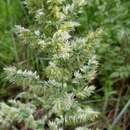en
names in breadcrumbs


Poa arachnifera, the Texas bluegrass, is a species of grass. It is a dioecious perennial plant, native to the southern Great Plains of the United States.[1]
During the 1990s, botanists began experimenting with producing hybrids of Texas bluegrass and Kentucky bluegrass (Poa pratensis) for use as wintering foraging plant for grazing livestock and as a drought-resistant lawn grass. The hybrids appear similar to Kentucky bluegrass, but maintain their green color in higher temperatures.[2] Seed manufacturers began marketing the first of these hybrids, often termed "heat-tolerant bluegrasses", in the first decade of the 21st century.
Poa arachnifera, the Texas bluegrass, is a species of grass. It is a dioecious perennial plant, native to the southern Great Plains of the United States.
Poa arachnifera, llamada comúnmente pasto azul de Texas, es una especie de gramínea.
En los 1990s, se comienza a experimentar con la producción de híbridos entre esta especie y Poa pratensis para obtener un pasto resistente a la sequía. El primer híbrido obtenido se comercializa como "pasto azul tolerante al calor,", ya en este siglo XXI.
Ejemplos de cultivares comerciales, en 2007, son:
Poa arachnifera fue descrita por (L.) Torr. y publicado en Exploration of the Red River of Louisiana 301. 1853.[1]
Poa arachnifera est une plante herbacée de la famille des Poacées. Elle a été décrite la première fois en 1853 par John Torrey. C'est une plante de 85 cm de haut, avec des feuilles simples et alternes présentant des nervures parallèles. Elle fleurit de mars à mai pour présenter des fleurs en panicules. On la rencontre sur des sols secs et frais en Amérique du Nord.
Selon Tropicos (26 octobre 2017)[2] :
Poa arachnifera est une plante herbacée de la famille des Poacées. Elle a été décrite la première fois en 1853 par John Torrey. C'est une plante de 25 à 85 cm de haut, avec des feuilles simples et alternes présentant des nervures parallèles. Elle fleurit de mars à mai pour présenter des fleurs en panicules. On la rencontre sur des sols secs et frais en Amérique du Nord.
Poa arachnifera là một loài cỏ trong họ hòa thảo, thuộc chi poa.[1]